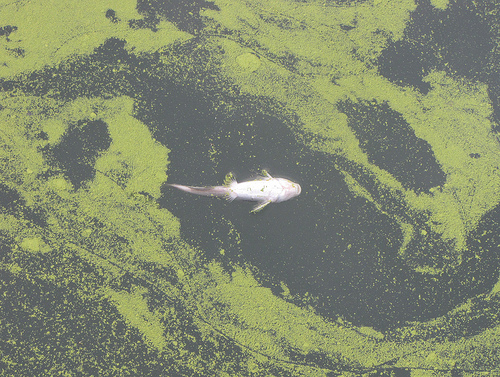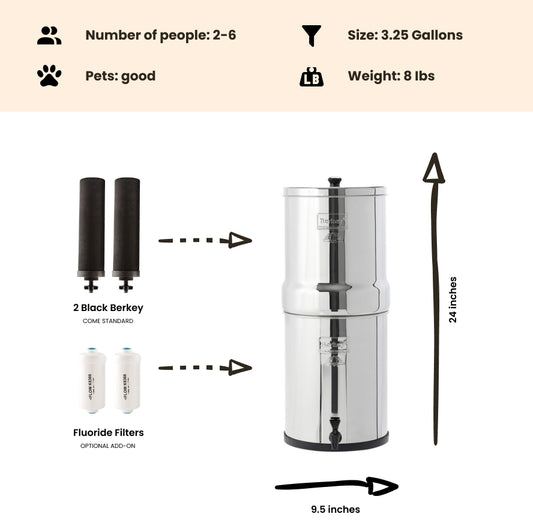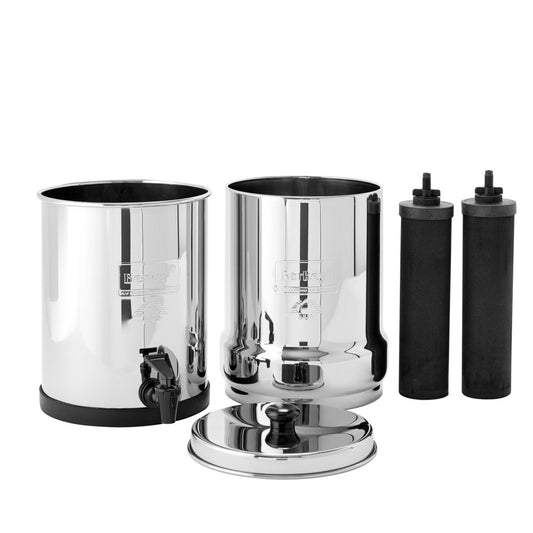
Algal Blooms Becoming More Toxic Due to Nutrient Enrichment & Changing Climate
By Dan DeBaunShare
Over the last few decades there has been an increase in toxic algal blooms in aquatic systems around the world primarily as a result of climate change and nutrient enrichment, which results in an abundance of toxic cyanobacteria, such as microcystin – a prolific cyanotoxin found worldwide that poses a serious threat to wildlife, natural ecosystems and human health. Microcystin is a potent liver toxin that is also potentially carcinogenic; consequently, it poses a serious health risk as a drinking water contaminant.
Update 7/15/2019 - The Berkey filters do remove Microcystin and Cyanotoxins from the water. For information on how the Berkey water filter performs removing this algae, please see Berkey Algae Bloom and Microcystin Removal Testing Results found here.
According to a study conducted by a team of scientists from Oregon State University and the University of North Carolina at Chapel Hill, which was recently published in Science, the proliferation of toxic strains of cyanobacteria will increase proportionately as nutrient enrichment increases in freshwater systems.
Cyanobacteria
Cyanobacteria are one of the oldest living organisms on our planet. They evolved around three-and-a-half billion years ago in an oxygen-free, barren world devoid of most life-forms, and by producing oxygen, played a fundamental role in transforming this lifeless world into what it is today and allowing higher life-forms to evolve. According to the scientists, these early pioneers readily adapt and persist in the environment and as our world changes they are once again adapting to changing environmental conditions, and to an extent threatening some of the life they originally allowed to develop.
Microcystis
Microcystis, a species of microcystin-producing cyanobacteria that flourishes in warm, slow flowing, nutrient-rich waters all over the world – is a strain that is particularly worrisome. It is able to migrate vertically within the water column, typically forming thick green algal mats on the water's surface. When conditions are optimal these toxin-producing cyanobacteria flourish and quickly out-compete and displace non-toxic cyanobacteria, resulting in algal blooms that are becoming more and more harmful.
“Cyanobacteria are basically the cockroaches of the aquatic world, they're the uninvited guest that just won't leave,” said Timothy Otten, a postdoctoral scholar in the OSU College of Science and College of Agricultural Sciences, and co-author of the study. “When one considers their evolutionary history and the fact that they've persisted even through ice ages and asteroid strikes, it's not surprising they're extremely difficult to remove once they've taken hold in a lake. For the most part, the best we can do is to try to minimize the conditions that favor their proliferation.”
There are over 123,000 large lakes (> 10 acres) spread throughout the US, and according to the latest EPA assessment a third or more contain toxic cyanobacteria. In some cases, such as Lake Erie, the area covered by algal blooms can be so vast that it is visible from space. Increasing temperatures and CO2 concentrations; dams; droughts; as well as nutrient runoff from agriculture, recreational and private land all exacerbate the situation.
Toxicity of Cyanobacteria and Microcystin
Scientists studying cyano-toxins believe that since cyanobacteria evolved before predators, it is unlikely that their original function was to be toxic. Recent studies suggest that microcystin – a potent liver toxin and potential carcinogen – has a protective function in cyanobacteria, helping them cope with oxidative stress, which may explain why the genes responsible for synthesizing the toxins are so ubiquitous across cyanobacteria species and why they still persist millions of years after they evolved. Because cyanobacteria need light to proliferate and the toxins are retained primarily within the microorganism, the risk of exposure is greatest on or near the surface of the water, which poses a danger to bathers, kayakers and other recreational users. “Also, since cyanobacteria blooms become entrenched and usually occur every summer in impacted systems, chronic exposure to drinking water containing these compounds is an important concern that needs more attention,” Otten said.
“Water quality managers have a toolbox of options to mitigate cyanobacteria toxicity issues, assuming they are aware of the problem and compelled to act,” Otten said. “But there are no formal regulations in place on how to respond to bloom events. We need to increase public awareness of these issues,” he stresses. “With a warming climate, rising carbon dioxide levels, dams on more rivers than not, and overloading of nutrients into our waterways, the magnitude and duration of toxic cyanobacterial blooms is only going to get worse.”
Journal Reference: Hans W. Paerl, Timothy G. Otten. Blooms Bite the Hand That Feeds Them. Science, 25 October 2013: Vol. 342 no. 6157 pp. 433-434 DOI: 10.1126/science.12452763
-
Regular price $234.00 USDRegular priceUnit price / per
-
Regular price $327.00 USDRegular priceUnit price / per
-
Regular price From $367.00 USDRegular priceUnit price / per
-
Regular price From $408.00 USDRegular priceUnit price / per
-

 Sold outRegular price From $451.00 USDRegular priceUnit price / per
Sold outRegular price From $451.00 USDRegular priceUnit price / per -
Regular price From $478.00 USDRegular priceUnit price / per
-
Regular price $332.50 USDRegular priceUnit price / per
$350.00 USDSale price $332.50 USDSale

Dan DeBaun is the owner and operator of Big Berkey Water Filters. Prior to Berkey, Dan was an asset manager for a major telecommunications company. He graduated from Rutgers with an undergraduate degree in industrial engineering, followed by an MBA in finance from Rutgers as well. Dan enjoys biohacking, exercising, meditation, beach life, and spending time with family and friends.
~ The Owner of Big Berkey Water Filters
















